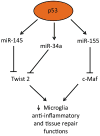The p53 Transcriptional Network Influences Microglia Behavior and Neuroinflammation
- PMID: 26853851
- PMCID: PMC5467747
- DOI: 10.1615/critrevimmunol.v35.i5.40
The p53 Transcriptional Network Influences Microglia Behavior and Neuroinflammation
Abstract
The tumor-suppressor protein p53 belongs to a family of proteins that play pivotal roles in multiple cellular functions including cell proliferation, cell death, genome stability, and regulation of inflammation. Neuroinflammation is a common feature of central nervous system (CNS) pathology, and microglia are the specialized resident population of CNS myeloid cells that initiate innate immune responses. Microglia maintain CNS homeostasis through pathogen containment, phagocytosis of debris, and initiation of tissue-repair cascades. However, an unregulated pro-inflammatory response can lead to tissue injury and dysfunction in both acute and chronic inflammatory states. Therefore, regulation of the molecular signals that control the induction, magnitude, and resolution of inflammation are necessary for optimal CNS health. We and others have described a novel mechanism by which p53 transcriptional activity modulates microglia behaviors in vitro and in vivo. Activation of p53 induces expression of microRNAs (miRNAs) that support microglia pro-inflammatory functions and suppress anti-inflammatory and tissue repair behaviors. In this review, we introduce the previously described roles of the p53 signaling network and discuss novel functions of p53 in the microglia-mediated inflammatory response in CNS health and disease. Ultimately, improved understanding of the molecular regulators modulated by p53 transcriptional activity in microglia will enhance the development of rational therapeutic strategies to harness the homeostatic and tissue repair functions of microglia.
Figures


Similar articles
-
The p53 transcription factor modulates microglia behavior through microRNA-dependent regulation of c-Maf.J Immunol. 2014 Jan 1;192(1):358-66. doi: 10.4049/jimmunol.1301397. Epub 2013 Dec 6. J Immunol. 2014. PMID: 24319262 Free PMC article.
-
Transcription factor p53 influences microglial activation phenotype.Glia. 2011 Oct;59(10):1402-13. doi: 10.1002/glia.21178. Epub 2011 May 19. Glia. 2011. PMID: 21598312 Free PMC article.
-
Phagocytic microglia and macrophages in brain injury and repair.CNS Neurosci Ther. 2022 Sep;28(9):1279-1293. doi: 10.1111/cns.13899. Epub 2022 Jun 25. CNS Neurosci Ther. 2022. PMID: 35751629 Free PMC article. Review.
-
Microglia Function in the Central Nervous System During Health and Neurodegeneration.Annu Rev Immunol. 2017 Apr 26;35:441-468. doi: 10.1146/annurev-immunol-051116-052358. Epub 2017 Feb 9. Annu Rev Immunol. 2017. PMID: 28226226 Free PMC article. Review.
-
Detection of microRNAs in microglia by real-time PCR in normal CNS and during neuroinflammation.J Vis Exp. 2012 Jul 23;(65):4097. doi: 10.3791/4097. J Vis Exp. 2012. PMID: 22872097 Free PMC article.
Cited by
-
Emergence of Microglia Bearing Senescence Markers During Paralysis Progression in a Rat Model of Inherited ALS.Front Aging Neurosci. 2019 Feb 28;11:42. doi: 10.3389/fnagi.2019.00042. eCollection 2019. Front Aging Neurosci. 2019. PMID: 30873018 Free PMC article.
-
Quantitative proteomics of acutely-isolated mouse microglia identifies novel immune Alzheimer's disease-related proteins.Mol Neurodegener. 2018 Jun 28;13(1):34. doi: 10.1186/s13024-018-0266-4. Mol Neurodegener. 2018. PMID: 29954413 Free PMC article.
-
A Unifying Hypothesis for the Genome Dynamics Proposed to Underlie Neuropsychiatric Phenotypes.Genes (Basel). 2024 Apr 8;15(4):471. doi: 10.3390/genes15040471. Genes (Basel). 2024. PMID: 38674405 Free PMC article. Review.
-
Neuroinflammation in Ischemic Stroke: Focus on MicroRNA-mediated Polarization of Microglia.Front Mol Neurosci. 2021 Jan 7;13:612439. doi: 10.3389/fnmol.2020.612439. eCollection 2020. Front Mol Neurosci. 2021. PMID: 33488360 Free PMC article. Review.
-
Virus-Induced Membrane Fusion in Neurodegenerative Disorders.Front Cell Infect Microbiol. 2022 Mar 24;12:845580. doi: 10.3389/fcimb.2022.845580. eCollection 2022. Front Cell Infect Microbiol. 2022. PMID: 35531328 Free PMC article. Review.
References
-
- Levine AJ, Hu W, Feng Z. The P53 pathway: what questions remain to be explored? Cell Death Differ. 2006;13(6):1027–36. - PubMed
-
- Vousden KH, Prives C. Blinded by the light: the growing complexity of p53. Cell. 2009;137(3):413–31. - PubMed
-
- Momand J, Zambetti GP, Olson DC, George D, Levine AJ. The mdm-2 oncogene product forms a complex with the p53 protein and inhibits p53-mediated transactivation. Cell. 1992;69(7):1237–45. - PubMed
Publication types
MeSH terms
Substances
Grants and funding
LinkOut - more resources
Full Text Sources
Research Materials
Miscellaneous

